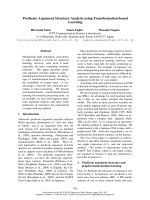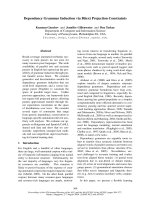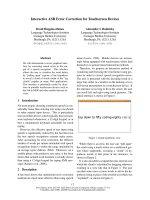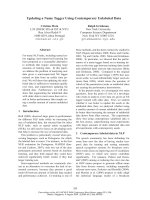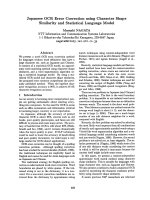Báo cáo khoa học: "Realistic Grammar Error Simulation using Markov Logic" potx
Bạn đang xem bản rút gọn của tài liệu. Xem và tải ngay bản đầy đủ của tài liệu tại đây (289.83 KB, 4 trang )
Proceedings of the ACL-IJCNLP 2009 Conference Short Papers, pages 81–84,
Suntec, Singapore, 4 August 2009.
c
2009 ACL and AFNLP
Realistic Grammar Error Simulation using Markov Logic
Sungjin Lee
Pohang University of Science and
Technology
Pohang, Korea
Gary Geunbae Lee
Pohang University of Science and
Technology
Pohang, Korea
Abstract
The development of Dialog-Based Computer-
Assisted Language Learning (DB-CALL) sys-
tems requires research on the simulation of
language learners. This paper presents a new
method for generation of grammar errors, an
important part of the language learner simula-
tor. Realistic errors are generated via Markov
Logic, which provides an effective way to
merge a statistical approach with expert know-
ledge about the grammar error characteristics
of language learners. Results suggest that the
distribution of simulated grammar errors gen-
erated by the proposed model is similar to that
of real learners. Human judges also gave con-
sistently close judgments on the quality of the
real and simulated grammar errors.
1 Introduction
Second Language Acquisition (SLA) researchers
have claimed that feedback provided during con-
versational interaction facilitates the acquisition
process. Thus, interest in developing Dialog-
Based Computer Assisted Language Learning
(DB-CALL) systems is rapidly increasing. How-
ever, developing DB-CALL systems takes a long
time and entails a high cost in collecting learners’
data. Also, evaluating the systems is not a trivial
task because it requires numerous language
learners with a wide range of proficiency levels
as subjects.
While previous studies have considered user
simulation in the development and evaluation of
spoken dialog systems (Schatzmann et al., 2006),
they have not yet simulated grammar errors be-
cause those systems were assumed to be used by
native speakers, who normally produce few
grammar errors in utterances. However, as tele-
phone-based information access systems become
more commonly available to the general public,
the inability to deal with non-native speakers is
becoming a serious limitation since, at least for
some applications, (e.g. tourist information, le-
gal/social advice) non-native speakers represent
a significant portion of the everyday user popula-
tion. Thus, (Raux and Eskenazi, 2004) conducted
a study on adaptation of spoken dialog systems
to non-native users. In particular, DB-CALL sys-
tems should obviously deal with grammar errors
because language learners naturally commit nu-
merous grammar errors. Thus grammar error si-
mulation should be embedded in the user simula-
tion for the development and evaluation of such
systems.
In Foster’s (2007) pioneering work, she de-
scribed a procedure which automatically intro-
duces frequently occurring grammatical errors
into sentences to make ungrammatical training
data for a robust parser. However the algorithm
cannot be directly applied to grammar error gen-
eration for language learner simulation for sever-
al reasons. First, it either introduces one error per
sentence or none, regardless of how many words
of the sentence are likely to generate errors.
Second, it determines which type of error it will
create only by relying on the relative frequencies
of error types and their relevant parts of speech.
This, however, can result in unrealistic errors. As
exemplified in Table 1, when the algorithm tries
to create an error by deleting a word, it would
probably omit the word ‘go’ because verb is one
of the most frequent parts of speech omitted re-
sulting in an unrealistic error like the first simu-
lated output. However, Korean/Japanese lan-
guage learners of English tend to make subject-
verb agreement errors, omission errors of the
preposition of prepositional verbs, and omission
errors of articles because their first language
does not have similar grammar rules so that they
may be slow on the uptake of such constructs.
Thus, they often commit errors like the second
simulated output.
81
This paper develops an approach to statistical
grammar error simulation that can incorporate
this type of knowledge about language learners’
error characteristics and shows that it does in-
deed result in realistic grammar errors. The ap-
proach is based on Markov logic, a representa-
tion language that combines probabilistic graphi-
cal models and first-order logic (Richardson and
Domingos, 2006). Markov logic enables concise
specification of very complex models. Efficient
open-source Markov logic learning and inference
algorithms were used to implement our solution.
We begin by describing the overall process of
grammar error simulation and then briefly re-
viewing the necessary background in Markov
logic. We then describe our Markov Logic Net-
work (MLN) for grammar error simulation. Fi-
nally, we present our experiments and results.
2 Overall process of grammar error si-
mulation
The task of grammar error simulation is to gen-
erate an ill-formed sentence when given a well-
formed input sentence. The generation procedure
involves three steps: 1) Generating probability
over error types for each word of the well-
formed input sentence through MLN inference 2)
Determining an error type by sampling the gen-
erated probability for each word 3) Creating an
ill-formed output sentence by realizing the cho-
sen error types (Figure 1).
3 Markov Logic
Markov logic is a probabilistic extension of finite
first-order logic (Richardson and Domingos,
2006). An MLN is a set of weighted first-order
clauses. Together with a set of constants, it de-
fines a Markov network with one node per
ground atom and one feature per ground clause.
The weight of a feature is the weight of the first-
order clause that originated it. The probability of
a state x in such a network is given by () =
(1/) (
()
), where is a normali-
zation constant,
is the weight of the th clause,
= 1 if the th clause is true, and
= 0 oth-
erwise.
Markov logic makes it possible to compactly
specify probability distributions over complex
relational domains. We used the learning and
inference algorithms provided in the open-source
Alchemy package (Kok et al., 2006). In particu-
lar, we performed inference using the belief
propagation algorithm (Pearl, 1988), and genera-
tive weight learning.
4 An MLN for Grammar Error Simula-
tion
This section presents our MLN implementation
which consists of three components: 1) Basic
formulas based on parts of speech, which are
comparable to Foster’s method 2) Analytic for-
mulas drawn from expert knowledge obtained by
error analysis on a learner corpus 3) Error limit-
ing formulas that penalize statistical model’s
over-generation of nonsense errors.
4.1 Basic formulas
Error patterns obtained by error analysis, which
might capture a lack or an over-generalization of
knowledge of a particular construction, cannot
explain every error that learners commit. Be-
cause an error can take the form of a perfor-
mance slip which can randomly occur due to
carelessness or tiredness, more general formulas
are needed as a default case. The basic formulas
are represented by the simple rule:
, , +
(, , +)
where all free variables are implicitly universally
quantified. The “ +, + ” notation signifies
that the MLN contains an instance of this rule for
each (part of speech, error type) pair. The evi-
Input sentence
He wants to go to a movie theater
Unrealistic simulated output
He wants to to a movie theater
Realistic simulated output
He want go to movie theater
Table 1: Examples of simulated outputs
Figure 1: An example process of grammar error simulation
82
dence predicate in this case is (, , ),
which is true iff the th position of the sentence
has the part of speech . The query predicate is
(, , ). It is true iff the th position
of the sentence has the error type , and infer-
ring it returns the probability that the word at
position would commit an error of type .
4.2 Analytic formulas
On top of the basic formulas, analytic formulas
add concrete knowledge of realistic error charac-
teristics of language learners. Error analysis and
linguistic differences between the first language
and the second language can identify various
error sources for each error type. We roughly
categorize the error sources into three groups for
explanation: 1) Over-generalization of the rules
of the second language 2) Lack of knowledge of
some rules of the second language 3) Applying
rules and forms of the first language into the
second language.
Often, English learners commit pluralization
error with irregular nouns. This is because they
over-generalize the pluralization rule, i.e. attach-
ing ‘s/es’, so that they apply the rule even to ir-
regular nouns such as ‘fish’ and ‘feet’ etc. This
characteristic is captured by the simple formula:
,
, ,
(, , __)
where
,
is true iff the
th word of the sentence is an irregular plural
and N_NUM_SUB is the abbreviation for substi-
tution by noun number error.
One trivial error caused by a lack of know-
ledge of the second language is using the singu-
lar noun form for weekly events:
, 1,
,
, ,
(, , __)
where
, 1,
is true iff the 1th
word is ‘on’ and
,
is true iff the
th word of the sentence is a noun describing
day like Sunday(s). Another example is use of
plurals behind ‘every’ due to the ignorance that a
noun modified by ‘every’ should be singular:
, ,
, ,
(, , __)
where
, ,
is true iff the
th word is the determiner of the th word.
An example of errors by applying the rules of
the first language is that Korean/Japanese often
allows omission of the subject of a sentence; thus,
they easily commit the subject omission error.
The following formula is for the case:
,
(, , __)
where
,
is true iff the th word is the
subject and N_LXC_DEL is the abbreviation for
deletion by noun lexis error.
1
4.3 Error limiting formulas
A number of elementary formulas explicitly
stated as hard formulas prevent the MLN from
generating improbable errors that might result
from over-generations of the statistical model.
For example, a verb complement error should not
have a probability at the words that are not com-
plements of a verb:
!
, ,
! (, , __).
where “!” denotes logically ‘not’ and “.” at the
end signifies that it is a hard formula. Hard formu-
las are given maximum weight during inference.
, ,
is true iff the th
word is a complement of the verb at the th po-
sition and V_CMP_SUB is the abbreviation for
substitution by verb complement error.
5 Experiments
Experiments used the NICT JLE Corpus, which
is speech samples from an English oral profi-
ciency interview test, the ACTFL-ALC Standard
Speaking Test (SST). 167 of the files are error
annotated. The error tagset consists of 47 tags
that are described in Izumi (2005). We appended
structural type of errors (substitution, addition,
deletion) to the original error types because
structural type should be determined when creat-
ing an error. For example, V_TNS_SUB consists
of the original error type V_TNS (verb tense) and
structural type SUB (substitution). Level-
specific language learner simulation was accom-
plished by dividing the 167 error annotated files
into 3 level groups: Beginner(level1-4), Interme-
diate(level5-6), Advanced(level7-9).
The grammar error simulation was compared
with real learners’ errors and the baseline model
using only basic formulas comparable to Foster’s
algorithm, with 10-fold cross validations per-
formed for each group. The validation results
were added together across the rounds to com-
pare the number of simulated errors with the
number of real errors. Error types that occurred
less than 20 times were excluded to improve re-
liability. Result graphs suggest that the distribu-
tion of simulated grammar errors generated by
the proposed model using all formulas is similar
to that of real learners for all level groups and the
1
Because space is limited, all formulas can be found at
83
proposed model outperforms the baseline model
using only the basic formulas. The Kullback-
Leibler divergences, a measure of the difference
between two probability distributions, were also
measured for quantitative comparison. For all
level groups, the Kullback-Leibler divergence of
the proposed model from the real is less than that
of the baseline model (Figure 2).
Two human judges verified the overall realism
of the simulated errors. They evaluated 100 ran-
domly chosen sentences consisting of 50 sen-
tences each from the real and simulated data. The
sequence of the test sentences was mixed so that
the human judges did not know whether the
source of the sentence was real or simulated.
They evaluated sentences with a two-level scale
(0: Unrealistic, 1: Realistic). The result shows
that the inter evaluator agreement (kappa) is
moderate and that both judges gave relatively
close judgments on the quality of the real and
simulated data (Table 2).
6 Summary and Future Work
This paper introduced a somewhat new research
topic, grammar error simulation. Expert know-
ledge of error characteristics was imported to
statistical modeling using Markov logic, which
provides a theoretically sound way of encoding
knowledge into probabilistic first order logic.
Results indicate that our method can make an
error distribution more similar to the real error
distribution than the baseline and that the quality
of simulated sentences is relatively close to that
of real sentences in the judgment of human eva-
luators. Our future work includes adding more
expert knowledge through error analysis to in-
crementally improve the performance. Further-
more, actual development and evaluation of a
DB-CALL system will be arranged so that we
may investigate how much the cost of collecting
data and evaluation would be reduced by using
language learner simulation.
Acknowledgement
This research was supported by the MKE (Ministry of
Knowledge Economy), Korea, under the ITRC (In-
formation Technology Research Center) support pro-
gram supervised by the IITA (Institute for Informa-
tion Technology Advancement) (IITA-2009-C1090-
0902-0045).
References
Foster, J. 2007. Treebanks Gone Bad: Parser evalua-
tion and retraining using a treebank of ungrammat-
ical sentences. IJDAR, 10(3-4), 129-145.
Izumi, E et al. 2005. Error Annotation for Corpus of
Japanese Learner English. In Proc. International
Workshop on Linguistically Interpreted Corpora
Kok, S. et al. 2006. The Alchemy system for statistic-
al relational AI.
Pearl, J. 1988. Probabilistic Reasoning in Intelligent
Systems Morgan Kaufmann.
Raux, A. and Eskenazi, M. 2004. Non-Native Users in
the Let's Go!! Spoken Dialogue System: Dealing
with Linguistic Mismatch, HLT/NAACL.
Richardson, M. and Domingos, P. 2006. Markov logic
networks. Machine Learning, 62(1):107-136.
Schatzmann, J. et al. 2006. A survey of statistical user
simulation techniques for reinforcement-learning
of dialogue management strategies, The Know-
ledge Engineering ReviewVol–
Advanced Level:
D
KL
(Real || Proposed)=0.068, D
KL
(Real || Baseline)=0.122
Intermediate Level:
D
KL
(Real || Proposed)=0.075, D
KL
(Real || Baseline)=0.142
Beginner Level:
D
KL
(Real || Proposed)=0.075, D
KL
(Real || Baseline)=0.092
Figure 2: Comparison between the distributions of the
real and simulated data
Human 1
Human 2
Average
Kappa
Real
0.84
0.8
0.82
0.46
Simulated
0.8
0.8
0.8
0.5
Table 2: Human evaluation results
84

